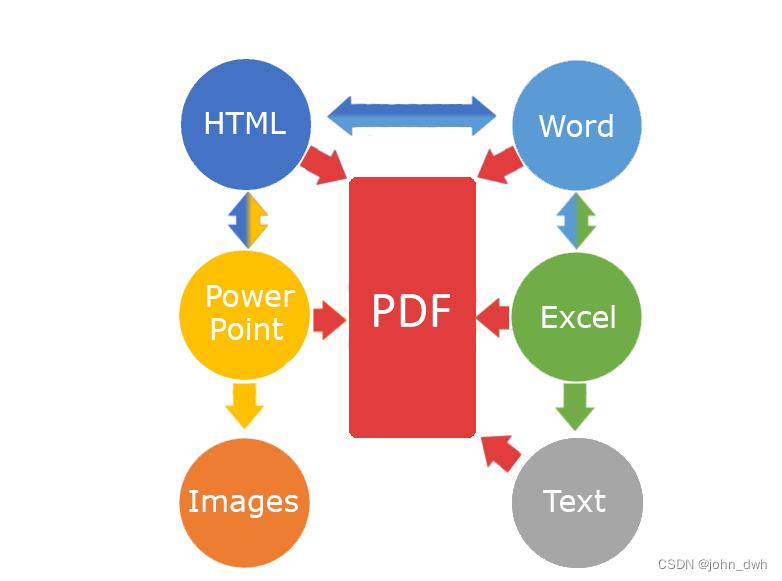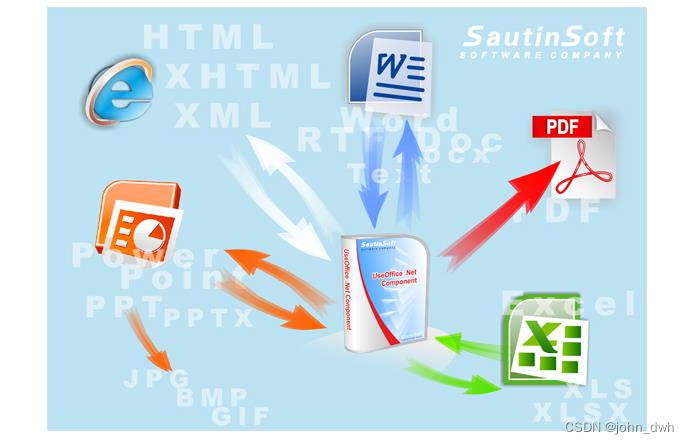UseOffice .Net 5.0 文档转换好帮手Crack
Posted john_dwh
tags:
篇首语:本文由小常识网(cha138.com)小编为大家整理,主要介绍了UseOffice .Net 5.0 文档转换好帮手Crack相关的知识,希望对你有一定的参考价值。

UseOffice .Net is a robust .NET component to convert between DOC, DOCX, XLS, RTF, PPT, PDF and html formats with tables, images, fonts, colors etc. Our component is just a class library, it requires Microsoft Office installed. You can install any version of MS Office from: 2000, XP, 2003, 2007, 2010, 2013, 2016 or 2019. It will not work with Office 365 and Office 2021 and higher (64-bit), because these verions don't support of OLE Automation.

Feature Highlights
Developers can integrate «UseOffice .Net» using VB.NET, C#, Delphi .NET or J# etc.
«UseOffice .Net» provides more than 40 various converting directions. Such as:
| DOC to HTML, XML | DOCX to HTML, XML | HTML to DOC |
| DOC to RTF | DOCX to RTF | HTML to RTF |
| DOC to TXT | DOCX to TXT | HTML to TXT |
| DOC to PDF | DOCX to PDF | HTML to PDF |
| DOC to DOCX | DOCX to DOC | |
| XLS to HTML, XML | RTF to HTML, XML | PPT to HTML, XML |
| XLS to TXT | RTF to TXT | PPT to RTF |
| XLS to CSV | RTF to DOC | PPT to PDF |
| XLS to RTF | RTF to PDF | PPT to JPG, BMP, GIF |
| XLS to PDF | Text to PDF | |
| XLSX to HTML, XML | Only for Office 2013: | |
| XLSX to TXT | PDF to DOCX | |
| XLSX to CSV | PDF to DOC | |
| XLSX to RTF | PDF to RTF | |
| XLSX to PDF | PDF to Text |
Requirements and Technical Information
UseOffice .Net is compatible with all .NET languages and supports Windows, where .NET Framework can be used. It's entirely written in C#. Requires MS Office, any version: 2000, XP, 2003, 2007, 2010, 2013, 2016 or 2019.
Requirements and Technical Information
-
Written in C# programming language.
-
Requires MS Office: 2000, XP, 2003, 2007, 2010, 2013, 2016, 2019 or 2022. (Office 365 is not supported).
-
.NET Framework 4.5, 4.6.1, 4.7 and up.
-
.NET Core 2.0, 2.1, 3.1.
-
.NET 5 and up.
-
.NET Standard 2.0 and up.
-
Works in Windows XP, Vista, 7, 8, 10, 11, Windows 2003/2008/2012/2016/2022 Server, Azure and so forth.
-
Can be easily integrated in any type of a 32-bit or 64-bit .NET application.
.NET - 将通用集合转换为 DataTable
【中文标题】.NET - 将通用集合转换为 DataTable【英文标题】:.NET - Convert Generic Collection to DataTable 【发布时间】:2010-10-16 14:50:45 【问题描述】:我正在尝试将通用集合 (List) 转换为 DataTable。我找到了以下代码来帮助我做到这一点:
// Sorry about indentation
public class CollectionHelper
private CollectionHelper()
// this is the method I have been using
public static DataTable ConvertTo<T>(IList<T> list)
DataTable table = CreateTable<T>();
Type entityType = typeof(T);
PropertyDescriptorCollection properties = TypeDescriptor.GetProperties(entityType);
foreach (T item in list)
DataRow row = table.NewRow();
foreach (PropertyDescriptor prop in properties)
row[prop.Name] = prop.GetValue(item);
table.Rows.Add(row);
return table;
public static DataTable CreateTable<T>()
Type entityType = typeof(T);
DataTable table = new DataTable(entityType.Name);
PropertyDescriptorCollection properties = TypeDescriptor.GetProperties(entityType);
foreach (PropertyDescriptor prop in properties)
// HERE IS WHERE THE ERROR IS THROWN FOR NULLABLE TYPES
table.Columns.Add(prop.Name, prop.PropertyType);
return table;
我的问题是,当我将 MySimpleClass 的属性之一更改为可空类型时,出现以下错误:
DataSet does not support System.Nullable<>.
如何在我的类中使用 Nullable 属性/字段来做到这一点?
【问题讨论】:
【参考方案1】:然后大概您需要使用Nullable.GetUnderlyingType 将它们提升为不可为空的形式,并且可能将一些null 值更改为DbNull.Value...
将分配更改为:
row[prop.Name] = prop.GetValue(item) ?? DBNull.Value;
当添加列时:
table.Columns.Add(prop.Name, Nullable.GetUnderlyingType(
prop.PropertyType) ?? prop.PropertyType);
而且它有效。 (?? 是 null 合并运算符;如果它是非 null 则使用第一个操作数,否则计算并使用第二个操作数)
【讨论】:
长大后,我想成为 Marc Gravell。 嗯。空合并运算符。太漂亮了。 在VB中,使用IF(Nullable.GetUnderlyingType(prop.PropertyType), prop.PropertyType)【参考方案2】:嗯。由于 DataSet 不支持可空类型,因此您必须检查属性是否为泛型类型,获取该类型的泛型定义,然后使用 Nullable.GetUnderlyingType 获取参数(这是实际类型)。如果值为 null,则只需在 DataSet 中使用DBNull.Value。
【讨论】:
【参考方案3】:如果Nullable.GetUnderlyingType() 给定您的prop.PropertyType 返回非空值,则将其用作列的类型。否则,请使用 prop.PropertyType 本身。
【讨论】:
【参考方案4】:我知道这个问题很老,但我对我所做的扩展方法也有同样的问题。使用 Marc Gravell 的响应,我能够修改我的代码。此扩展方法将处理原始类型、字符串、枚举和具有原始属性的对象的列表。
using System;
using System.Collections.Generic;
using System.ComponentModel;
using System.Data;
using System.Linq;
using System.Text;
/// <summary>
/// Converts a List<T> to a DataTable.
/// </summary>
/// <typeparam name="T">The type of the list collection.</typeparam>
/// <param name="list">List instance reference.</param>
/// <returns>A DataTable of the converted list collection.</returns>
public static DataTable ToDataTable<T>(this List<T> list)
var entityType = typeof (T);
// Lists of type System.String and System.Enum (which includes enumerations and structs) must be handled differently
// than primitives and custom objects (e.g. an object that is not type System.Object).
if (entityType == typeof (String))
var dataTable = new DataTable(entityType.Name);
dataTable.Columns.Add(entityType.Name);
// Iterate through each item in the list. There is only one cell, so use index 0 to set the value.
foreach (T item in list)
var row = dataTable.NewRow();
row[0] = item;
dataTable.Rows.Add(row);
return dataTable;
else if (entityType.BaseType == typeof (Enum))
var dataTable = new DataTable(entityType.Name);
dataTable.Columns.Add(entityType.Name);
// Iterate through each item in the list. There is only one cell, so use index 0 to set the value.
foreach (string namedConstant in Enum.GetNames(entityType))
var row = dataTable.NewRow();
row[0] = namedConstant;
dataTable.Rows.Add(row);
return dataTable;
// Check if the type of the list is a primitive type or not. Note that if the type of the list is a custom
// object (e.g. an object that is not type System.Object), the underlying type will be null.
var underlyingType = Nullable.GetUnderlyingType(entityType);
var primitiveTypes = new List<Type>
typeof (Byte),
typeof (Char),
typeof (Decimal),
typeof (Double),
typeof (Int16),
typeof (Int32),
typeof (Int64),
typeof (SByte),
typeof (Single),
typeof (UInt16),
typeof (UInt32),
typeof (UInt64),
;
var typeIsPrimitive = primitiveTypes.Contains(underlyingType);
// If the type of the list is a primitive, perform a simple conversion.
// Otherwise, map the object's properties to columns and fill the cells with the properties' values.
if (typeIsPrimitive)
var dataTable = new DataTable(underlyingType.Name);
dataTable.Columns.Add(underlyingType.Name);
// Iterate through each item in the list. There is only one cell, so use index 0 to set the value.
foreach (T item in list)
var row = dataTable.NewRow();
row[0] = item;
dataTable.Rows.Add(row);
return dataTable;
else
// TODO:
// 1. Convert lists of type System.Object to a data table.
// 2. Handle objects with nested objects (make the column name the name of the object and print "system.object" as the value).
var dataTable = new DataTable(entityType.Name);
var propertyDescriptorCollection = TypeDescriptor.GetProperties(entityType);
// Iterate through each property in the object and add that property name as a new column in the data table.
foreach (PropertyDescriptor propertyDescriptor in propertyDescriptorCollection)
// Data tables cannot have nullable columns. The cells can have null values, but the actual columns themselves cannot be nullable.
// Therefore, if the current property type is nullable, use the underlying type (e.g. if the type is a nullable int, use int).
var propertyType = Nullable.GetUnderlyingType(propertyDescriptor.PropertyType) ?? propertyDescriptor.PropertyType;
dataTable.Columns.Add(propertyDescriptor.Name, propertyType);
// Iterate through each object in the list adn add a new row in the data table.
// Then iterate through each property in the object and add the property's value to the current cell.
// Once all properties in the current object have been used, add the row to the data table.
foreach (T item in list)
var row = dataTable.NewRow();
foreach (PropertyDescriptor propertyDescriptor in propertyDescriptorCollection)
var value = propertyDescriptor.GetValue(item);
row[propertyDescriptor.Name] = value ?? DBNull.Value;
dataTable.Rows.Add(row);
return dataTable;
【讨论】:
这行得通!但仅限于可为空的类型。您需要添加语句“if (underlyingType == null)underlyingType = entityType;”在你的“bool typeIsPrimitive = originalTypes.Contains(underlyingType);”之前所以它也适用于 List这是一个经过一些修改的版本,允许使用 null 和 '\0' 字符而不会破坏 DataTable。
using System;
using System.Collections;
using System.Collections.Generic;
using System.Reflection;
using System.Data;
namespace SomeNamespace
public static class Extenders
public static DataTable ToDataTable<T>(this IEnumerable<T> collection, string tableName)
DataTable tbl = ToDataTable(collection);
tbl.TableName = tableName;
return tbl;
public static DataTable ToDataTable<T>(this IEnumerable<T> collection)
DataTable dt = new DataTable();
Type t = typeof(T);
PropertyInfo[] pia = t.GetProperties();
object temp;
DataRow dr;
for (int i = 0; i < pia.Length; i++ )
dt.Columns.Add(pia[i].Name, Nullable.GetUnderlyingType(pia[i].PropertyType) ?? pia[i].PropertyType);
dt.Columns[i].AllowDBNull = true;
//Populate the table
foreach (T item in collection)
dr = dt.NewRow();
dr.BeginEdit();
for (int i = 0; i < pia.Length; i++)
temp = pia[i].GetValue(item, null);
if (temp == null || (temp.GetType().Name == "Char" && ((char)temp).Equals('\0')))
dr[pia[i].Name] = (object)DBNull.Value;
else
dr[pia[i].Name] = temp;
dr.EndEdit();
dt.Rows.Add(dr);
return dt;
【讨论】:
以上是关于UseOffice .Net 5.0 文档转换好帮手Crack的主要内容,如果未能解决你的问题,请参考以下文章